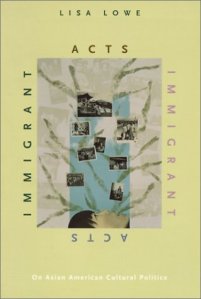Peer-Review: 0
Chin, Soo-Young, Feng, Peter X, and Lee Josephine. “Asian American Cultural Production.” Journal of Asian American Studies 3.3 (2000): 298-282. Print.
Written as an introduction to the journal in 2000, the writers examine the proliferation of discourse around “Asian American cultural production” as a means of re-visioning understandings of ‘culture’ within Asian American Studies. Temporally, this essay is positioned not only at the turn of the millennium, but also as a middle point between Lisa Lowe’s Immigrant Acts and Kandice Chuh’s Imagine Otherwise. Consequently, this piece offers an astute analysis of the distinct linkage between “Asian American” and “cultural production” and affords the possibility of extending upon as well as highlighting the limits of both theoretical frameworks.
Framing ‘culture’ within the discourse of cultural nationalism in Asian American Studies, the writers highlight the three forms in which ‘culture’ now manifest: (1) intellectual, spiritual, and aesthetic development; (2) idea about a way of life; and, (3) intellectual and aesthetic activity (271). Asian American culture, the writers argue, is “inherently activist” (271) given its emergence as resistance against dominant images perpetuated by the hegemonic culture, which possesses representational power. Thus, discourses around Asian American culture must always address the relationship to this history of activism. Cultural nationalism was useful in fostering “what [Chele] Sandoval terms an oppositional consciousness” (271; emphasis added) and building a collective political identity. Furthermore, it beckoned an examination of the everyday in a site of creating Asian American culture and also a site in which problematic ideologies are exposed.
In the debate surrounding ‘culture,’ the writers point to continuing tensions between those with a more theoretical basis in striving for disciplinary legitimacy and academic recognition and those who stress the need to connect act with goals of social activism. Asian American culture must then negotiate these multiple visions in order to establish the connection between the aesthetic and political that is necessary to effect social change. The section “The Social Imaginary: Toward a Theory of Cultural Production and Consumption” is particularly apt in conceptualizing the multifaceted players and processes within “cultural production.” The writers stress the need to examine not only the creation of art, but also its consumption. Inherent in the examination of consumption are interrogations of who the intended consumers are and why. The writers beckon us to understand “culture as simultaneously a material and a symbolic production” (273). This notion echoes needs for critiquing disciplinary boundaries, as argued for in an Asian Americanist critique. The writers apply Paul Ricoeur’s concept of “the social imaginary” to frame “Asian American” as a collective of history and practices that influence current textual production (experience). The medium through which this imaginary materializes into experience is the fictive. In what ways can we extend this framing of Asian American culture as “the fictive” in order to rethink Chuh’s urge to read literature as theory?

